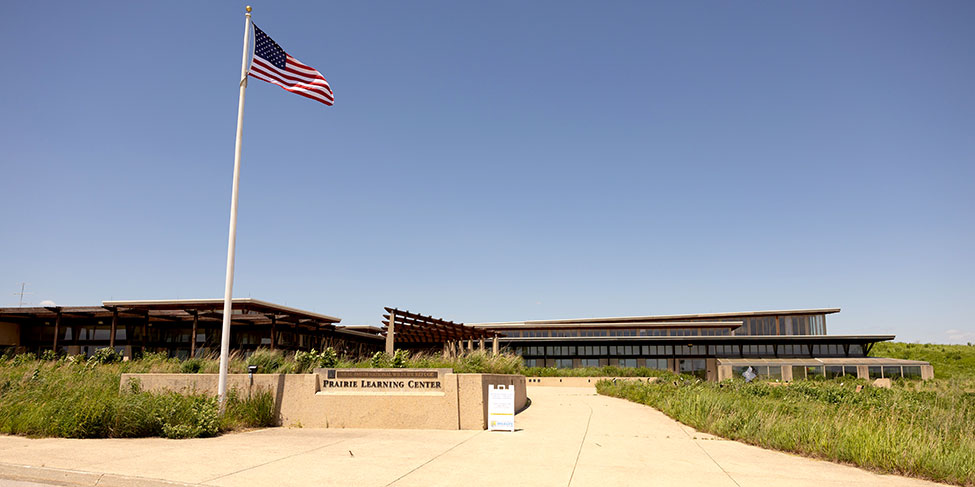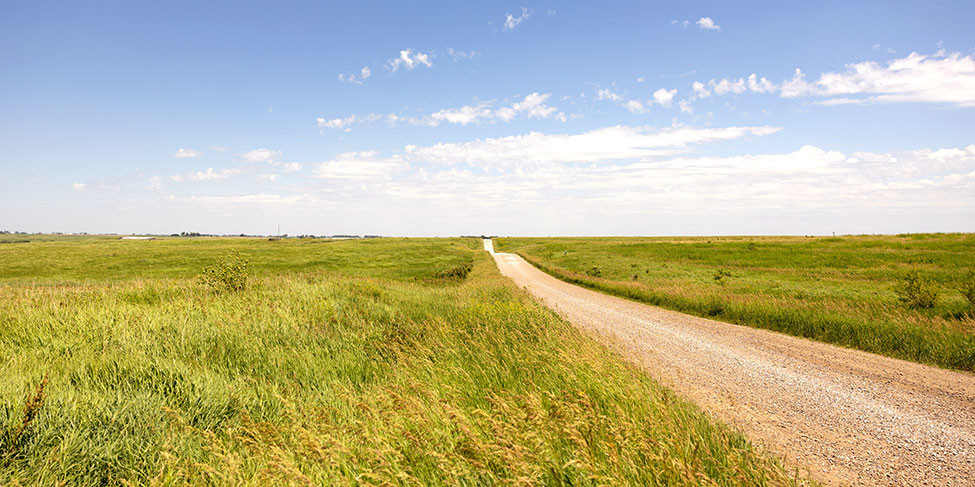Rebuilding the Prairie That Built Iowa’s Soil
June 14, 2024
By April Pearson
Settling Soil
A hundred years ago, Iowa was part of one of the largest ecosystems in the world, a contiguous prairie that spanned from Canada to Texas and Illinois to Nebraska. Iowa’s prairie once hosted a diversity of life on par with a rainforest. Today, only one-tenth of one percent of the original prairie remains.
When European settlers arrived in the mid-1800s, they discovered the incredible soil that prairie grass had cultivated. “These root systems, to a great extent, created the rich soil,” says Nancy Corona, visitor services manager at Neal Smith National Wildlife Refuge, “because over thousands of years, the roots decomposed and created this nutrient-rich, organic matter that’s now ideal for growing crops, the basis of our economy.” To better their lives, the settlers began turning prairie land into farmland, resulting in the sharp decline of native prairie plants and animals. Something had to be done to preserve the flora and fauna vital to Iowa’s economy, the environment and our heritage. And while it may seem counterintuitive to revert farmland to prairie, it’s better for agriculture in the long run. “It's not just about wildlife,” says Corona, “it's about the health of our environment and the foundation of our agricultural industry. It’s important to find a balance to support farmers and agriculture, as well as support the prairie and mitigate the impact of farming practices.”
 Prairie Prancers
Prairie Prancers
Formerly called the Walnut Creek National Wildlife Refuge, the Neal Smith National Wildlife Refuge, located in Prairie City, was created in 1990 to actively protect, restore, reconstruct and manage native ecosystems of tallgrass prairie, oak savanna and sedge meadow. In 1991, the Refuge bought its first 3,600 acres — cropland originally slated to be a nuclear power generating station. In 1992, planting began.
“It was a big undertaking,” says Corona. “It was the largest reconstruction of a tallgrass prairie using local ecotype seeds.” Before this, there’d been reconstruction using seeds from Minnesota, Missouri or western Iowa, but those seeds are genetically different from the local plants. Corona continues, “So they sent a team to the 38 surrounding counties and found little parcels of original prairie with some seeds. They went to more than 200 sites, including cemeteries, ditches, private land, railroad tracks — areas that were just forgotten or too rugged to plow.”
To grow, prairie seeds must be scattered, spread out and in full contact with the soil, so the Refuge hosted a “Sow Your Wild Oats” party to kick off planting. Says Corona, “They had a dance party with music, and people danced on the seeds to get them in the ground.”
 Photo Credit: Nancy Corona
Photo Credit: Nancy Corona
Bison, Birds and Bees
In 1998, the Walnut Creek National Wildlife Refuge was renamed the Neal Smith National Wildlife Refuge in honor of the congressman who advocated for its creation. His efforts, and those of countless others, have been an enormous success. Managed by the U.S. Fish and Wildlife Service, the Refuge currently has 6,000 acres of wildlife habitat — 4,000 acres of which are reconstructed tallgrass prairie. “We're preserving the genetics of plants that could be lost forever,” says Corona, “and the wildlife is making a comeback.”
Today, you can find plants in every color of the rainbow, like blue-eyed grass, purple spiderwort, orange butterfly milkweed, yellow compass plant and goldenrods. You can also see animals and insects that were once on the decline, including bison, which were near extinction; elk, which used to be common on the prairie; and butterflies and bees — important crop pollinators. Grassland birds had been hit especially hard, with a 53% reduction in their overall population — the greatest bird decline in any single terrestrial biome. Corona says, “You're seeing things like Henslow’s Sparrows, Short-Eared Owls, Northern Harriers — all those grassland birds that can't live elsewhere. Now they’re thriving.”
 Heritage Hub
Heritage Hub
The Neal Smith National Wildlife Refuge serves as a hub for education, recreation and engagement, with lots of things to do and ways to get involved. There’s an impressive visitor’s center with exhibits, a nature store, conference rooms and indoor/outdoor eating. There’s also an auto tour loop and miles of trails. Volunteers collect and clean seeds, help in the visitor center and work in the greenhouse. Thousands of people visit to hike, bike, ski, snowshoe, picnic, forage for berries and mushrooms, and watch wildlife. “Our bison and elk enclosure is 800 acres of wild prairie,” says Corona. “Who doesn't want to see a bison herd?”
Visitors of all ages and interests — from preschoolers to college kids and Rotary Club members to Red Hat Ladies — come to learn about how the Neal Smith National Wildlife Refuge is preserving Iowa’s prairie and heritage. “A lot of people from Iowa wonder what it was like for their ancestors to come through the prairie,” says Corona. “It’s historically and culturally significant. There aren’t many places left where you can see large tracts of prairie like their ancestors did.”
 Conservation Cooperation
Conservation Cooperation
Preserving Iowa's prairie is crucial for a sustainable Iowa. That’s why the Refuge encourages adopting conservation practices that benefit private landowners and the general public — like incorporating prairie strips into farm fields.
Large swaths of prairie among crops and around streams help build soil and prevent soil loss. “Prairie built Iowa’s world-famous soil that provides the backbone for our economy,” Corona says, “and it takes hundreds of years to build just a little bit of soil.” Prairie strips also help prevent water runoff, filter pollutants, sequester carbon and provide a habitat for pollinators. “About 75% of the world’s flowering plants and 35% of the world’s food crops depend on animal pollinators to reproduce. If you don't have the prairie to support them, that will hurt our food chain and access.”
Ultimately, the Neal Smith National Wildlife Refuge is about providing corridors for wildlife and plants to thrive, supporting farmers and agriculture and improving the lives of Iowans.